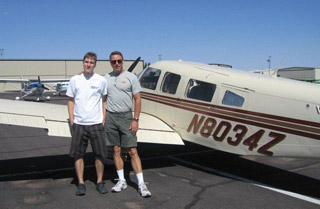
The Eight Ball Flying Club, based out of California’s Van Nuys Airport, was started in 1962 by three members who shared a single Cessna 180. In 1979, the then-five members bought a brand new Cessna 172 that the club still has today. “Our club’s name was a tough, but ironic one for a flying club. You don’t hear names like ours too often,” said Kelly Bakst, the club’s maintenance officer.
Bakst said that when he joined the club 13 years ago, it was still operating a 1969 Cessna 182 and the 172. “Neither was in very good shape, primarily because the focus was on saving money everywhere possible, and, as you know, that doesn't work when it comes to safety,” he said.
 Several of members decided to revamp the financial model of the club, said Bakst. “Maintenance and safety became our number one priority. We soon found ourselves acquiring new aircraft and expanding the club,” he said. “Our model works for as many airplanes as we want, assuming volunteers continue to step up the way they have been. So we find ourselves now completely full with 65 members and five airplanes.” The club has its original 1979 Cessna 172, refreshed with new paint, interior, and glass; a 2002 Cessna 172SP; a 2000 Cessna 182; a 2002 Diamond DA40; and a 1982 Piper Saratoga.
Several of members decided to revamp the financial model of the club, said Bakst. “Maintenance and safety became our number one priority. We soon found ourselves acquiring new aircraft and expanding the club,” he said. “Our model works for as many airplanes as we want, assuming volunteers continue to step up the way they have been. So we find ourselves now completely full with 65 members and five airplanes.” The club has its original 1979 Cessna 172, refreshed with new paint, interior, and glass; a 2002 Cessna 172SP; a 2000 Cessna 182; a 2002 Diamond DA40; and a 1982 Piper Saratoga.
The club is currently undertaking the full automation of its scheduling and billing/accounting systems, thanks to two members who are systems developers, said Bakst. “We are nearly complete. Scheduling and reporting of hours are online, payments are accepted electronically and applied to balances, and we are working on a key locker system that will control access automatically,” he said.
The club operates as a 501(c)(7) nonprofit, said Bakst. “The idea here is that through the work of a few volunteers, we can all enjoy the reduced costs and camaraderie of the club, without dealing with all that comes with turning a profit,” he said. “But we are in the process of speaking with an attorney to see if this is the best structure for us.”
There is a $3,500 buy-in for the club, said Bakst. “It’s also becoming a fairly healthy secondary market for selling memberships when people want out,” he said. “Dues are $140 a month, which we feel is the lowest possible rate.”
 Anyone can instruct in the club’s aircraft after a minor checkout with one of its CFIs, said Bakst. “Being nonprofit, it is up to the instructor to negotiate rates, but the students in the club continually say that it is easily 40 percent cheaper to learn with us than with any school in the area.” The club has eight approved instructors and 12 students in various phases of training, he added.
Anyone can instruct in the club’s aircraft after a minor checkout with one of its CFIs, said Bakst. “Being nonprofit, it is up to the instructor to negotiate rates, but the students in the club continually say that it is easily 40 percent cheaper to learn with us than with any school in the area.” The club has eight approved instructors and 12 students in various phases of training, he added.
The club does fly-ins and group events, ranging from a few people going up to get current to 20 people going to Vegas, said Bakst. “We are very active with Young Eagles and do lots of charity flying for local groups,” he said.
Bakst advises groups wanting to form or expand their clubs to ask questions of existing organizations. “Use our bylaws and operating rules and try not to re-invent the wheel. We've been doing this a long time, and have been through a lot of painful lessons,” he said. “Sixty-five people, five planes, and a lot of expenses is tough for a small group of volunteers if you don't know what you are doing.”


